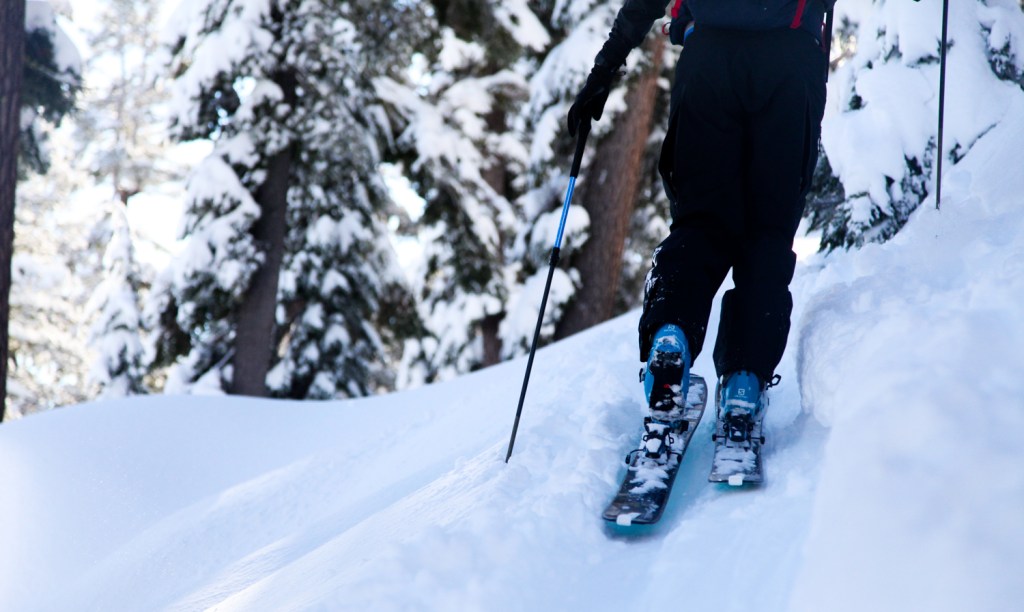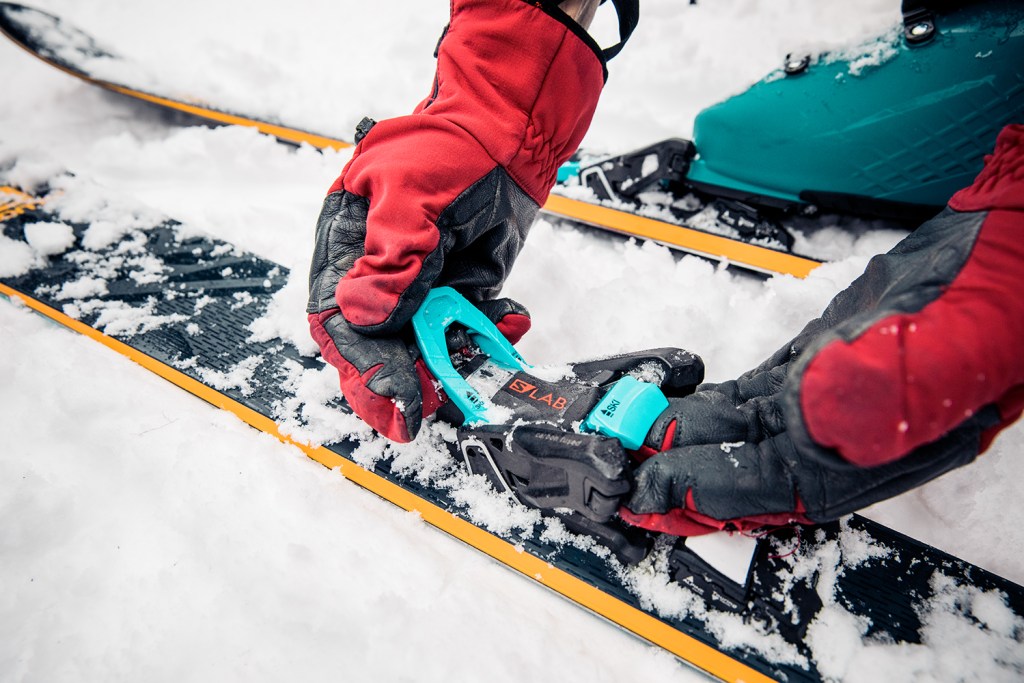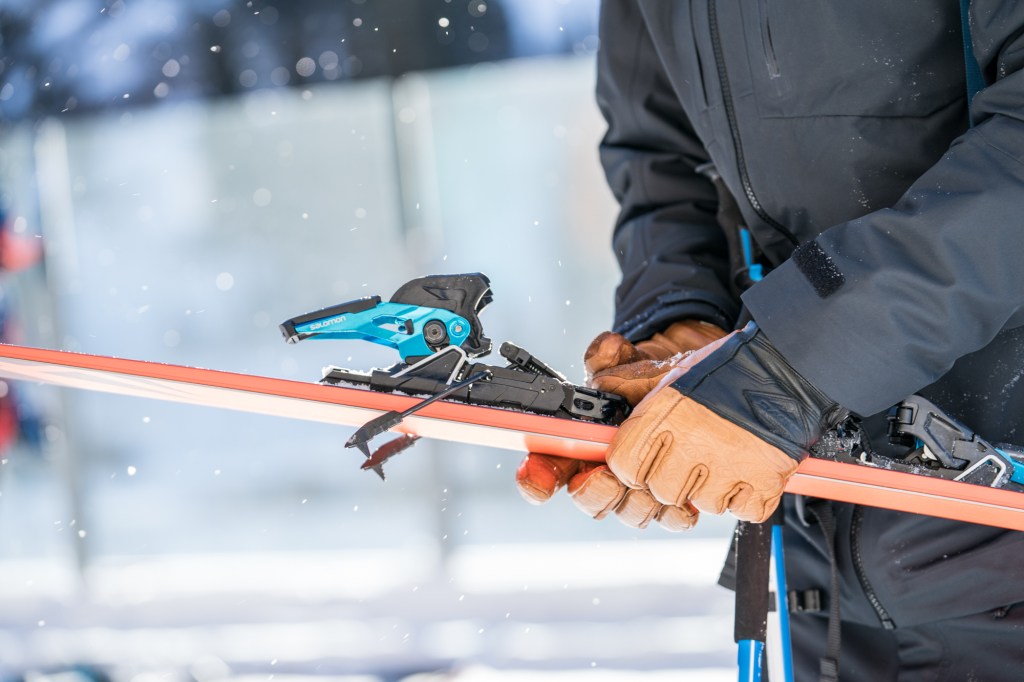Editor’s note on February 11, 2019: Due to the popularity of the Salomon S/Lab Shift MNC binding, inventory levels may vary.
Pro skier Cody Townsend and I are gearing up to climb Jake’s Peak, a popular backcountry ski route on Lake Tahoe’s West Shore. Conditions are ideal—fresh snow fell across the Sierra a few days earlier and the north-facing trees off Jake’s should be holding light, cold snow. But first, I’ve got to learn how to use my bindings.
I’m here to test Salomon’s new and much-anticipated S/Lab Shift MNC Binding, which has been flying off store shelves since it was stocked this fall. Everyone in the ski industry has been talking about the Shift since it debuted at last year’s Winter Outdoor Retailer show. We took a first look at the binding last year, but I’d never had a chance to ski it—until now.
Overview
- Pros: Free pivot mode makes touring uphill easy; sturdy, lightweight materials give it a trustworthy downhill performance without excessive heft and bulk; can be used with nearly all types of ski boots.
- Cons: Not as lightweight as other tech bindings; could use a third climbing bar height for extra steep skin tracks.
- Best for: Skiers who split their time between the resort and the backcountry. If you’re riding inbounds most of the time with an occasional short to medium-distance backcountry tour, you no longer need separate skis for all of those outings.
- Price: $549.95

Cody Townsend gives the author a rundown on how the new Salomon Shift binding works.
Uphill performance
Townsend, a Salomon athlete who helped test and develop this binding over the last seven years, gives me the rundown on how to use it. First, he says, flick the switch on the toe piece into hike mode (it’s well marked and easy to flip), then lock down the brakes on the heel piece (also easy, even with gloves on). Lastly, step the toe of your boot into the toe piece and lift the lock to secure for the uphill. Done. Now I’m ready to start skinning. I wore alpine touring boots, but the MNC in the Shift’s name stands for Multi-Norm Certified, which means, if you’re skiing downhill at a resort in this binding, you can also use standard alpine ski boots.
Weight
At a weight of 1,730 grams per pair, the Shift isn’t the lightest touring binding on the market (it’s twice the weight of some of Dynafit’s most lightweight tech binding and about 200 grams heavier than the popular Marker Kingpin 13), but it’s certainly not the heaviest either. As soon as I started uphill, I noticed how swift and light the whole rig felt, just like my lighter tech bindings. Thanks to the Shift’s smartly designed pivot point, your heel can lift the full 90 degrees, which makes kick-turning and skinning feel like a breeze (even when it isn’t).
Climbing bar
When the skin track got steep, I flicked up the climbing bar—a heel riser on the Shift offers two- and 10-degree ramp angles—easily with a tap of my ski pole. “Some people wanted a third, higher level of the climbing bar for when the skin track gets really steep,” Townsend tells me on the way uphill. “But that would have added more weight. And besides, we shouldn’t be setting our skin tracks so steep.”

The binding’s 90-degree pivot makes them feel lighter than they are while climbing uphill.
Innovation behind the Shift
The idea for the Shift was born on a houseboat on Arizona’s Lake Powell in 2012. Salomon’s ski athletes, product managers and engineers had gathered for a team meeting. In between rock climbing and waterskiing, they discussed the future of Salomon’s ski products. “It was the single most productive meeting we’ve ever had,” Townsend said. “Most of the products you see in our line now were discussed and visualized there.”
On the last day of the trip, as they were motoring back to the docks, one of the binding engineers asked, “What’s next in bindings?” The company was about to release the Salomon T Guardian MNC alpine touring binding, which could tour uphill and ski downhill like an alpine binding but wasn’t exactly lightweight like a tech binding. Townsend and fellow Salomon athlete Chris Rubens had already discussed their vision for the binding of the future. “We were like, ‘We want an alpine binding that tours like a pin binding, one that has a better pivot point so you’re not lifting up a big frame,’” Townsend said.
Two years later, engineers at Salomon’s Annecy, France, headquarters had developed a prototype. It had promise but was barely skiable. Then, in 2014, Salomon hired a French engineer named Benoit Sublet and tasked him to lead the binding project. Sublet, a downhill mountain bike racer, had been working for a company that builds mountain bikes for people with disabilities before he joined Salomon.
Within two years, Sublet built the blueprint for the Shift binding we see today. With performance feedback from Salomon’s athletes, who were testing the binding on snow, Sublet made subtle tweaks, fine-tuning everything from mount points to ramp angle. But it still lacked the downhill performance the athletes were looking for.
“The biggest challenge on the S/Lab Shift binding was to make the breakthrough concept of the toe with the two-in-one mode—touring uphill and alpine downhill—with lightness,” Sublet said. “It required a lot of prototype iterations, many new molds and double our development lead time.”

Switching the Shift between ski and hike mode is easy—even with gloves on.
Then, in 2017, Sublet heard of a carbon composite plastic that Ferrari was using in its cars. He got ahold of the plastic and used that to build the entire binding. “That was the magic bullet,” Townsend said. “It was like the whole characteristics of the binding changed. It was stronger, stiffer, had absolutely no play. Right off the bat, we were like, this skis like an alpine binding. It was a night and day difference in downhill performance.”
Ultimately, it took seven years of development, 20 different prototypes and more than 50 molds to build the Shift binding, making it the costliest product to date and the longest product development from concept to market in Salomon’s history, according to Chris McKearin, Salomon’s United States alpine commercial manager.
McKearin told me they expected the Shift to do well when it launched in fall 2018—Salomon manufactured considerably more than a typical binding order based on initial retailer feedback, preseason purchase orders and forecasted reorders—but even then, they couldn’t have anticipated the hefty demand for this sought-after binding. “The strong start to the winter in the West and the strength of the early adopters has led the S/Lab Shift MNC 13 to exceed expectations,” McKearin said.

It took seven years and 20 different prototypes to build the Shift binding.
Transitions
Eventually, Townsend and I reached the top of Jake’s Peak, climbing above the milky cloud layer into a stunning, clear blue day. We stopped to admire the view of Lake Tahoe, eat a snack and change out our gear for the descent. To switch into ski mode on the binding was a snap: Unlock the brakes on the heel piece, then pull the wings on the toe piece together, switching into a well-marked ski mode, and the pins magically disappeared. Suddenly, it looked just like any alpine binding you’d ski at the resort. With a DIN range of 6 to 13, any hardy skier can push it on the descent on this binding.
“This binding is meant to be beat up on the hill. It’s meant to ski the resort,” Townsend said. “I filmed all last winter on these bindings, sending 50-foot cliffs with full confidence.”
Downhill performance
I wasn’t planning on launching any cliffs on the way down, but I did open up my turns on the descent, pushing the bindings to full speed and not feeling any sense of weakness or movement. A few days later, I spent an entire day skiing the Shift at my local ski area, lapping high-speed runs from top to bottom without hesitation.
The consensus
The S/Lab Shift delivered a light, free pivot mode on the uphill, but it was the downhill where it truly shined, offering a confidence and stability rarely found in a touring binding.
Technical specs
| Best Use |
Backcountry Skiing
|
|---|---|
| Boot Compatibility |
Downhill, Tech
|
| Lowest DIN |
6
|
| Highest DIN |
13
|
| Adjustment Range |
30 millimeters
|
| Brake Width (mm) |
90 MM: 90 millimeters
100 MM: 100 millimeters
110 MM: 110 millimeters
|
| Heel Lift |
Yes
|
| Weight (Pair) |
1700 grams
|
